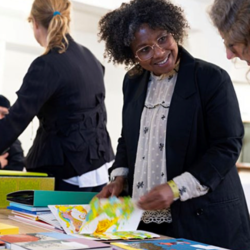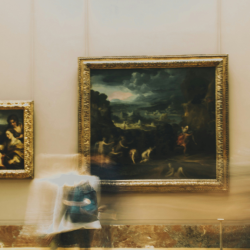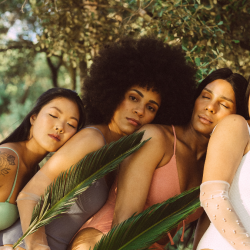I’m writing this in the magnificent Royal Exchange Theatre in Manchester. Earlier this month I saw legendary drum & bass DJ Goldie play an intimate set in the basement room at the local venue Joshua Brooks. Next week, I’ll visit the Royal Northern College of Music to watch a screening of 1920 horror flick The Cabinet of Dr. Caligari with a live improvised organ score, and I’ll visit The Lowry to watch an experimental play titled, Mushroom Language: A Fungal Gothic.
Ain’t culture brilliant?
The UK’s creative industries were worth more than £115bn to the UK economy before the pandemic — more than aerospace, life sciences and the car industries combined. A vibrant arts and culture scene makes for a happier, healthier society, and fuels creativity beyond the walls of theatres, galleries, and nightclubs.
But is art, culture, and creativity being properly cared for?
The current Culture Secretary, Lucy Frazer, claims our creative industries are ‘a key priority’. The government’s Creative industries sector vision, published earlier this year, talks about big ambitions to grow the sector by an extra £50bn and create a million extra jobs by 2030. It promises £75m of new investment, putting total public funding in the creative industries at £310m since 2021. This follows on from the £1.6bn Culture Recovery Fund, which helped the arts survive Covid-19 (and puts the newer, smaller numbers in perspective).
For more context, France announced a record budget of £3.86bn for culture last year, and Germany is investing £2bn in the arts.
Despite the eye-catching targets trumpeted by the Tories, arts organisations, arts education, and artists themselves, are struggling.
Funding redistribution and backlash
Last year, Arts Council England cut £50m of grants in London to redistribute funding outside of the capital. This included the controversial withdrawal of funding for the English National Opera, which drew press criticism and protests, and led to a u-turn, with the ENO now funded until 2029.
It’s true that many of our cultural crown jewels are in London, and stripping them of funding makes little sense. But local government funding for the arts has fallen 43% since 2008, and there’s no other money around to fill that gap.
In Scotland, as reported by Katie Goh in gal-dem, ‘2023 began with a proposed 10% cut to Creative Scotland, who warned that reduced funding would impact 50% of the national arts funding body’s organisations. Thanks to pressure from campaigners and unions, this proposal was abandoned in February.‘
Paltry pay for artists keeps underprivileged people out
An easy way to gauge the health of public arts funding is to look at how much artists get paid for public commissions. Incredibly, it averages less than £3/hour. In the Industria report Structurally F-cked, they warn that ‘bad pay for artists means a homogeneous and elitist ‘art world’.’
It’s rare for artists to make a living without a day job or side hustle. Korantema Anyimadu, Youth Voice Lead at Arts Emergency, says, ‘in six years of working at Arts Emergency, this is the most bleak I’ve seen the arts.‘
Creative subjects in decline at schools and universities
The UK is home to the top two ranked art and design schools in the world (the RCA and UAL), but the overall picture is less encouraging. Since 2010, arts enrolment has dropped by 47% at GCSE and 29% at A-level, with the biggest drops at state schools in deprived areas. As Olivia Hingley writes for It’s Nice That, ‘cuts to the arts in state schools will have a catastrophic impact both on the individual future of creatives, and the industry at large.’
In 2021, the Tories cut funding for arts subjects at higher education level by 50%, and redirected the money to STEM. In May, the University of Brighton announced that it was closing the Brighton Centre for Contemporary Arts (CCA), pointing to ‘very significant’ funding challenges. More than two dozen arts and humanities jobs were cut by the University of East Anglia this year, and ‘between a third and half’ of art and design courses have been eliminated at the University of Wolverhampton.
Would things be different under Labour? In July, Keir Starmer promised to reprioritise creativity and other ‘human’ skills. This was welcomed in an open letter signed by Grayson Perry, Olivia Colman, Patrick Stewart and more than 100 others. The letter laments that ‘for too long, the creative arts have been squeezed out of the mainstream curriculum and have become a pursuit that only the most privileged can follow.’ In September, shadow Culture Secretary Thangam Debbonaire pledged that creative arts will be at the core of school curriculums under a Labour government.
Disappearing nightclubs and live music
In the decade up to 2017, the UK lost half of its nightclubs. Between June 2020 and June 2023, 30% of the clubs that remained closed down; around 12% of those closures happened in the 12 months up to June this year. And there was a 17% decline in live music performances in 2022 vs 2019.
What can be done? Temporary superclubs, aka ‘meanwhile projects’, like London’s Printworks (above, due to return in 2026) and Drumsheds (below, in an old Ikea in Tottenham) may be part of the solution, making the most of otherwise empty spaces.
In Manchester, the Music Venue Trust is pushing for the new Co-Op Live Arena to invest a percentage of ticket revenue in the city’s grass roots live music ecosystem.
Marketing ❤️ the arts
Head to MediaCat’s about page and you’ll find these words: ‘We consider marketing to be a stray cat, one that’s always loved the arts.‘ The creative energy of the arts permeates industries like ours. It feeds us new ideas and fires our imaginations. It expands our minds and nourishes our souls. It gives us new symbols and stories we can reference and remix.
As well as being an unending source of inspiration, there’s a strong case to be made that the wider creative industries could also be a bigger force of intervention, applying creativity and artistic practices to all manner of serious challenges. As Hasan Bakhshi, Director of the Creative Industries Policy and Evidence Centre, argues we are yet to secure the place of the creative industries in ‘mainstream policies in areas like education, skills, immigration and the climate emergency.‘
That’s a missed opportunity.
Caroline Norbury, Chief Executive of Creative UK, says ‘the UK is bursting with creative brilliance, but too often a lack of opportunities or barriers to success prevent these talents from flourishing.‘
What can you do? Vote Labour, buy art, support your local independent venues, and consider donating to Campaign for the Arts.
Featured image: Mike Piggott































